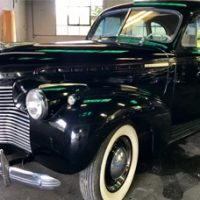Chevrolet EA Master

Many people believe that the first real automobiles rolled off the assembly line in the 1930s. Before then, cars really were more like horseless carriages. In addition to design innovations, especially in the mid to latter part of the decade, there were a number of technical innovations as well. Higher-end automobiles were quite popular despite the Great Depression. Many Americans still lived fairly luxurious lives and their spending money suddenly went a lot further than it did earlier.
Chevrolet’s Master series pretty much had all these things, so it was a true product of its times. With a sticker price of just under $700, the Master was one of the highest-priced Chevrolets of that era. Masters were also some of the first vehicles with all-steel turret tops as well as driver-friendly features like roll-down windows and heaters.
1933 and 1934 Masters
To accommodate customers who expected something a little extra, the first Masters had wider wheelbases that meant roomier interiors. 1934 models also had upgraded “Stovebolt Six” engines. With some modifications, these engines were standard on all Chevrolets through the 1950s and most models through 1990. The bigger and heavier Masters needed those extra two cylinders (the old Chevy engines were four cylinders).
The Master was available in 2-door coupe, 4-door sedan, and 2-door pickup configurations. In fact, the Master was one of the last Chevrolets which had both commercial and noncommercial models. Going forward, General Motors and other manufacturers would make both types of vehicles, but they would be two separate product lines. This divergence was one of the first indicators that the automobile market was expanding and that the auto industry was expanding as well.
1935-37 Masters
The 1935 Master was the first one with the aforementioned turret top. Before then, most cars had canvas and steel tops. The canvas had to be replaced often, usually at least once a year. Although 1935 was well before the age of automobile safety, manufacturers used the additional steel as a selling point. A Buick sales brochure proclaimed that the “luxurious turret top” was “the safest, strongest body built.”
The sleek, all-steel top very quickly became the industry standard. Besides being hassle-free and reducing drag, the tops simply looked much better. And, as cars became longer, slenderer, and less carriage-like, those new tops turned heads.
By 1937, Master sales were strong enough that they displaced the lower-priced Standard Six. The even more upscale Master Deluxe appeared that year as well. These vehicles had a bit more chrome and some other extras as well.
1938-1940 Masters
Buoyed by the early success of the more luxurious Masters, GM pushed the envelope. For a while, this approach worked. The 1938 Master and Master Deluxe were some of the best-selling Chevrolets of the decade. Improvements included a still-wider wheel base, eye-catching horizontal lines, and heavier valve springs.
But as the Great Depression dragged on, sales began to slump. By 1939, they were down over 40 percent. The Chevrolet Deluxe replaced the Master after the 1940 model year. This car had a good run as well. Many people consider the Deluxe to be the signature Chevrolet of the 1940s.








